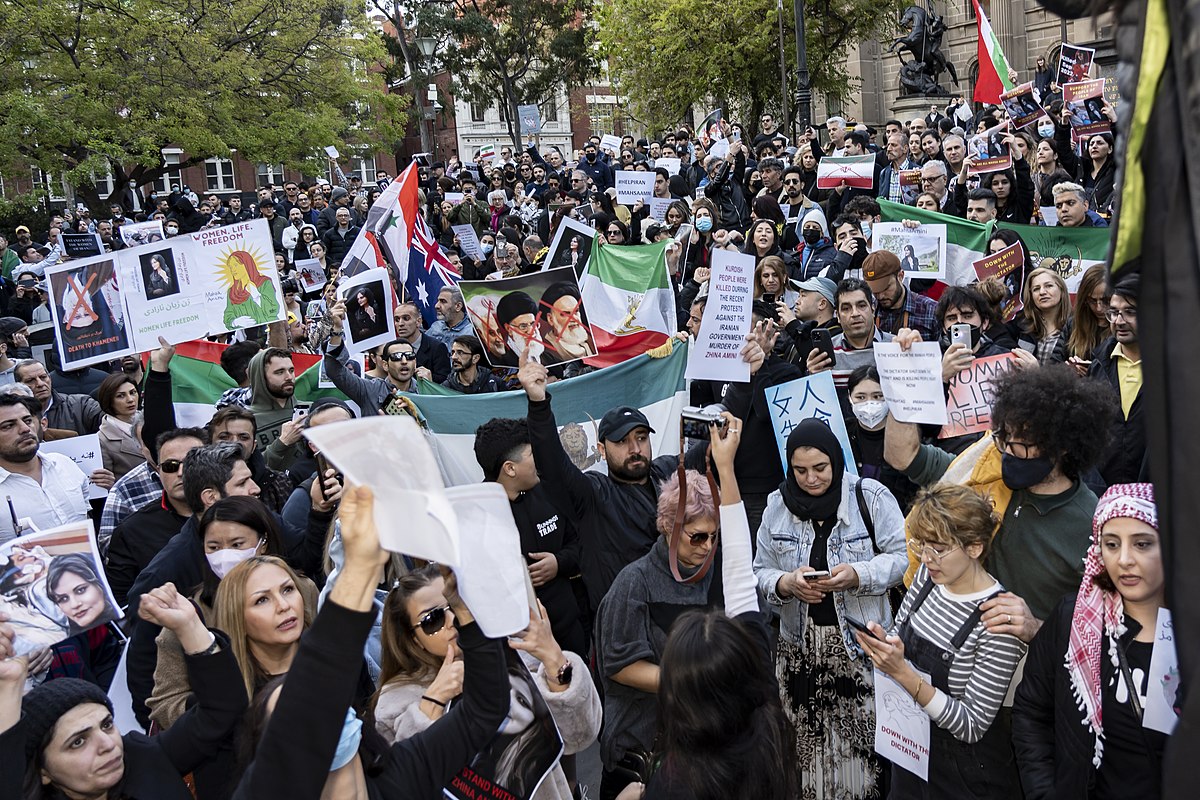
Iranian protests continue with no end in sight
OUTRAGE FOR CHANGE: Thousands around the world have gathered in solidarity against Iran’s Islamic Regime. Protesters have faced violence as they rally against the regime’s human rights violations. Photo courtesy of Matt Hrkac
By: Sonia Gidwani
After the death of Kurdish journalist Mahsa Amini by Iran’s Morality Police, protests have continued for over six months consistently. Women have taken to the streets in solidarity with Amini, chanting “Women, Life, Freedom”, a phrase derived from the Kurdish freedom struggle in Syria, pioneering the way for change in the government with men and children behind them.
Amini, an Iranian woman, died in custody on Sept. 16, 2022 for improperly wearing her hijab, a head covering worn by Muslim women to conceal their hair. The Iranian government reported that she died of a heart attack while in coma at a hospital, but protesters have asserted that she was in a coma as a result of undergoing torture while in police custody. When this news became public, rallies began during Amini’s funeral and spread throughout the nation within days. The protesters aim to overthrow the Islamic Regime, revoke religious legislation, dissolve the Morality Police, reform the government and prosecute the killers of Amini.
“It reflects the anger and frustrations of multiple generations of women who are now supporting one another,” said Sussan Tahmasebi, a director of Femena, a group supporting human rights protestors in the Middle East. “It is grandmothers, mothers, daughters and great-granddaughters who have had to tolerate this violence and humiliation over many years.”
After Amini’s arrest, speculations have risen that the Morality Police, the branch of the Iranian government that enforces religious law, had a hand in her subsequent death. This has caused an uproar across the country, and citizens took to the streets to protest by publicly burning hijabs. Citizens of Iran are demanding change in their government and have refused to back down.
“What you see is people who are fed up with a regime,” said Director of the Iran Human Rights organization, Mahmood Amiry-Moghaddam. “Not only do they take away people’s civil and political rights, but they also interfere in people’s most private aspects of life, like what you wear.”
Protesters in Iran have utilized non-violent methods of demonstration, such as burning hijabs, cutting hair and holding strikes at school and work. In contrast, there has been evidence of the use of machine guns and poisonous chemical gas used by the Morality Police against schoolgirls. At the 2022 World Cup in Qatar, Iran’s national team refused to sing their national anthem at their first match. However, when the Iranian government threatened that their families would be met with “violence and torture” if they protested in any way, they complied at their following match. Human Rights Activists in Iran, a group that’s been tracking the protests, estimates that as of March 2023, over 19,700 protesters have been arrested.
“These protests could spark change. It is uncertain if the Ayatollah would be willing to give them change, but hopefully it could spark some kind of government protest and a new regime could come in.” stated senior president of Model United Nations Angelina Michalowski.
As a result of government intervention, there have been an estimated 1,160 injuries and 598 deaths, including over 70 minors and four known executions by April 2023. From children as young as two years old to seniors as old as 70, people of all ages have been killed in the regime’s attempts to quell protests. On October 23, 2022, two young girls were traveling to school when the police began shooting at the car, killing 8-year-old Mona Naghib. Throughout October 2022, numerous high school girls were arrested for promoting support for the protests, including 15-year-old Mandana Nemati. There have been no updates regarding their whereabouts. The Iranian security forces have taken measures to silence the anger of citizens. With the death of 17-year-old Setareh Tajik, 16-year-old Samer Hashem Zehieher and 16-year-old Nima Shafagh Doust, their families were threatened and forced to remain silent. Iran has utilized internet restrictions to prevent protesters from sharing information about the country’s unrest. When the protests began, 1500 Tasvir received over 3,000 videos every day. After internet restrictions, the number has dropped to about 100 to 200 videos per day.
“The internet gets cut every day at 3 or 4 p.m. and doesn’t come back until around midnight or 1 a.m.,” stated a protester in Marivan, Iran. “None of the big apps like Instagram or WhatsApp or Telegram work.”
Activists around the world have taken to the streets in solidarity with those in Iran. Citizens in Afghanistan, Paris, Turkey and Washington D.C. have protested and called upon their political leaders to take action against the Iranian government. The National Solidarity Group of Iran has organized rallies for over four months in front of Iran’s embassy in the United States.
“I want to show my Iranian sisters at home that they have nothing to fear,” stated protester Rose at the Washington D.C. protests. “We see you and we are with you. You will prevail.”
Even with unprecedented support, there are still obstacles to bringing change. Although polls have shown that over 80 percent of Iranians renounce the Islamic Regime, the number of protesters in Iran does not reflect this as many fear the violence of the Morality Police. Despite these challenges, these protests have brought together numerous groups around the world who oppose the Islamic Regime, and protests and rallies are likely to continue worldwide until change is made in the Iranian government.
“It has been proven throughout history that protests and levels of action taken against the government can truly change a nation’s future,” said junior Model UN and International Relations member Emmanuel Huertas. “In America, we have the civil rights movement for people of color, women’s suffrage, LGBTQ+ rights, and more. Many of these great strides in history were made through protest and outrage for change.”

